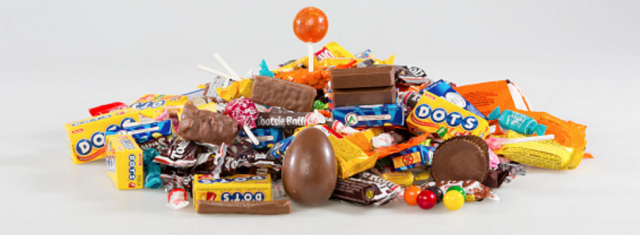
“For me, a calorie is a unit of measurement that’s a real pain in the rear.”
Bo Nash is 38. He lives in Arlington, Texas, where he’s a technology director for a textbook publisher. He has a wife and child. And he’s 5’10” and 245 lbs—which means he is classed as obese.
In an effort to lose weight, Nash uses an app to record the calories he consumes and a Fitbit band to track the energy he expends. These tools bring an apparent precision: Nash can quantify the calories in each cracker crunched and stair climbed. But when it comes to weight gain, he finds that not all calories are equal. How much weight he gains or loses seems to depend less on the total number of calories and more on where the calories come from and how he consumes them. The unit, he says, has a “nebulous quality to it."
Tara Haelle is also obese. She had her second son on St Patrick’s Day in 2014 and hasn’t been able to lose the 70 lbs she gained during pregnancy. Haelle is a freelance science journalist based in Illinois. She understands the science of weight loss, but like Nash, she doesn’t see it translate into practice. “It makes sense from a mathematical and scientific and even visceral level that what you put in and what you take out, measured in the discrete unit of the calorie, should balance,” says Haelle. “But it doesn’t seem to work that way.”
Nash and Haelle are in good company. More than two-thirds of American adults are overweight or obese. For many of them, the cure is diet: one in three are attempting to lose weight in this way at any given moment. Yet there is ample evidence that diets rarely lead to sustained weight loss. These are expensive failures. This inability to curb the extraordinary prevalence of obesity costs the United States more than $147 billion in healthcare, $4.3 billion in job absenteeism, and even more in lost productivity.
At the heart of this issue is a single unit of measurement—the calorie—and some seemingly straightforward arithmetic. “To lose weight, you must use up more calories than you take in,” according to the Centers for Disease Control and Prevention. Dieters like Nash and Haelle could eat all their meals at McDonald’s and still lose weight provided they burn enough calories, says Marion Nestle, professor of nutrition, food studies, and public health at New York University. “Really, that’s all it takes.”
But Nash and Haelle do not find weight control so simple. And part of the problem goes way beyond individual self-control. The numbers logged in Nash’s Fitbit or printed on the food labels that Haelle reads religiously are at best good guesses. Worse yet, as scientists are increasingly finding, some of those calorie counts are flat-out wrong—off by more than enough, for instance, to wipe out the calories Haelle burns by running an extra mile on a treadmill. A calorie isn’t just a calorie. And our mistaken faith in the power of this seemingly simple measurement may be hindering the fight against obesity.
Where the calories come from
The process of counting calories begins in an anonymous office block in Maryland. The building is home to the Beltsville Human Nutrition Research Center, a facility run by the US Department of Agriculture. When we visit, the kitchen staff are preparing dinner for people enrolled in a study. Plastic dinner trays are laid out with meatloaf, mashed potatoes, corn, brown bread, a chocolate-chip scone, vanilla yoghurt and a can of tomato juice. The staff weigh and bag each item, sometimes adding an extra two-centimeter sliver of bread to ensure a tray’s contents add up to the exact calorie requirements of each participant. “We actually get compliments about the food,” says David Baer, a supervisory research physiologist with the Department.
The work that Baer and colleagues do draws on centuries-old techniques. Nestle traces modern attempts to understand food and energy back to a French aristocrat and chemist named Antoine Lavoisier. In the early 1780s, Lavoisier developed a triple-walled metal canister large enough to house a guinea pig. Inside the walls was a layer of ice. Lavoisier knew how much energy was required to melt ice, so he could estimate the heat the animal emitted by measuring the amount of water that dripped from the canister. What Lavoisier didn’t realize—and never had time to find out; he was put to the guillotine during the Revolution—was that measuring the heat emitted by his guinea pigs was a way to estimate the amount of energy they had extracted from the food they were digesting.
Until recently, the scientists at Beltsville used what was essentially a scaled-up version of Lavoisier’s canister to estimate the energy used by humans: a small room in which a person could sleep, eat, excrete, and walk on a treadmill, while temperature sensors embedded in the walls measured the heat given off and thus the calories burned. (We now measure this energy in calories. Roughly speaking, one calorie is the heat required to raise the temperature of one kilogram of water by one degree Celsius.) Today, those ‘direct-heat’ calorimeters have largely been replaced by ‘indirect-heat’ systems, in which sensors measure oxygen intake and carbon dioxide exhalations. Scientists know how much energy is used during the metabolic processes that create the carbon dioxide we breathe out, so they can work backwards to deduce that, for example, a human who has exhaled 15 liters of carbon dioxide must have used 94 calories of energy.
The facility’s three indirect calorimeters are down the halls from the research kitchen. “They’re basically nothing more than walk-in coolers, modified to allow people to live in here,” physiologist William Rumpler explains as he shows us around. Inside each white room, a single bed is folded up against the wall, alongside a toilet, sink, a small desk and chair, and a short treadmill. A couple of airlocks allow food, urine, faeces and blood samples to be passed back and forth. Apart from these reminders of the room’s purpose, the vinyl-floored, fluorescent-lit units resemble a 1970s dorm room. Rumpler explains that subjects typically spend 24 to 48 hours inside the calorimeter, following a highly structured schedule. A notice pinned to the door outlines the protocol for the latest study:
6:00 to 6:45pm—Dinner,
11:00pm—Latest bedtime, mandatory lights out,
11:00pm to 6:30am—Sleep, remain in bed even if not sleeping.
In between meals, blood tests and bowel movements, calorimeter residents are asked to walk on the treadmill at 3 miles per hour for 30 minutes. They fill the rest of the day with what Rumpler calls “low activity."
“We encourage people to bring knitting or books to read,” he says. “If you give people free hand, you’ll be surprised by what they’ll do inside the chamber.” He tells us that one of his less cooperative subjects smuggled in a bag of M&Ms and then gave himself away by dropping them on the floor.
Using a bank of screens just outside the rooms, Rumpler can monitor exactly how many calories each subject is burning at any moment. Over the years, he and his colleagues have aggregated these individual results to arrive at numbers for general use: how many calories a 120-lb woman burns while running at 4.0 miles an hour, say, or the calories a sedentary man in his 60s needs to consume every day. It’s the averages derived from thousands of extremely precise measurements that provide the numbers in Bo Nash’s movement tracker and help Tara Haelle set a daily calorie intake target that is based on her height and weight.

Measuring the calories in food itself relies on another modification of Lavoisier’s device. In 1848, an Irish chemist called Thomas Andrews realized that he could estimate calorie content by setting food on fire in a chamber and measuring the temperature change in the surrounding water. (Burning food is chemically similar to the ways in which our bodies break food down, despite being much faster and less controlled.) Versions of Andrews’s ‘bomb calorimeter’ are used to measure the calories in food today. At the Beltsville center, samples of the meatloaf, mashed potatoes and tomato juice have been incinerated in the lab’s bomb calorimeter. “We freeze-dry it, crush into a powder, and fire it,” says Baer.
Humans are not bomb calorimeters, of course, and we don’t extract every calorie from the food we eat. This problem was addressed at the end of the 19th century, in one of the more epic experiments in the history of nutrition science. Wilbur Atwater, a Department of Agriculture scientist, began by measuring the calories contained in more than 4,000 foods. Then he fed those foods to volunteers and collected their faeces, which he incinerated in a bomb calorimeter. After subtracting the energy measured in the faeces from that in the food, he arrived at the Atwater values, numbers that represent the available energy in each gram of protein, carbohydrate and fat. These century-old figures remain the basis for today’s standards. When Baer wants to know the calories per gram figure for that night’s meatloaf, he corrects the bomb calorimeter results using Atwater values.
reader comments
428